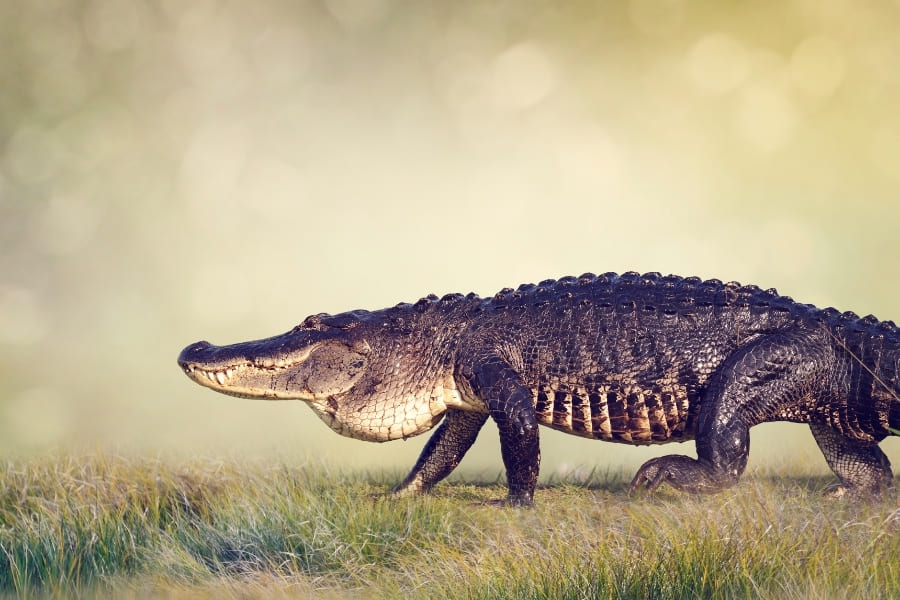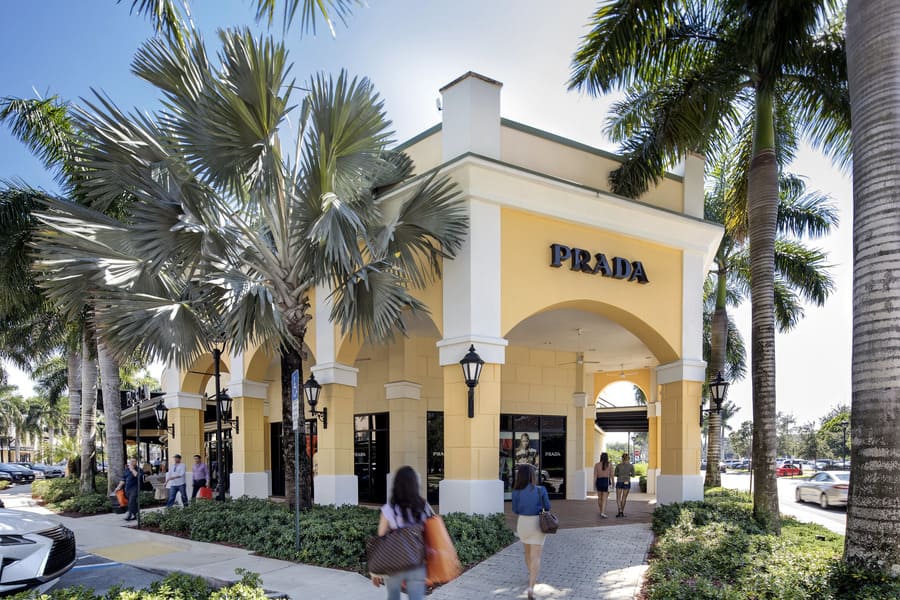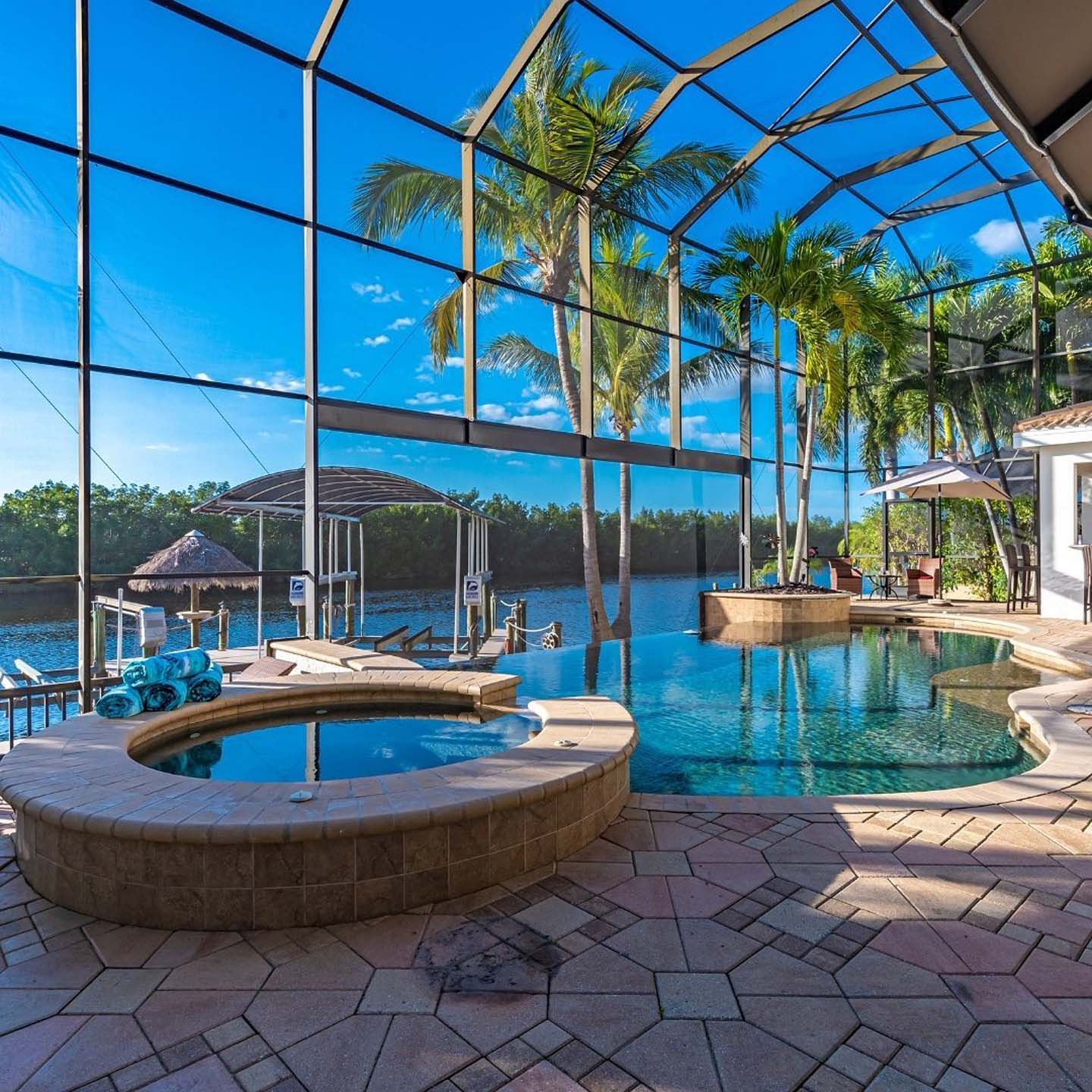They are found in Florida’s rivers and swamps, sometimes even in swimming pools and on golf courses: Alligators and crocodiles are the Sunshine State’s most iconic animals. Nowhere else in the USA do you have such ample opportunity to see these giants – in Gator Parks, zoos and in the wild. But what are the best places to watch them? How can you tell alligators and crocodiles apart? And what should you do in case of an encounter? Find out more in this article.
Alligator Facts
You want to increase your knowledge about Florida’s iconic reptiles before visiting the zoo or going on an air boat trip? Then, you should check out these alligator facts:
Alligator Species
In total, the Alligatoridae family is comprised of eight species that split into alligators and caimans. Florida is home to the American alligator. In addition, there are Chinese alligators that are much smaller than their brethren in the New World. All six known caiman species live in South and Latin America.
Alligator Size and Weight
On average, American alligators reach a size of 10 ft and a weight of 500 lbs. However, the biggest individual ever caught weighed a whopping 992 lbs and measured 16 ft in length.
Alligator Habitat
Alligators predominantly live in fresh water habitats such as rivers, lakes and swamps. However, due to the population growth in Florida, alligators are sometimes found on golf courses and in swimming pools. Alligators in the sewer, however, are an urban myth. Down there, the conditions would be too dark and cold for these animals.
Alligator Food and Behavior
Being true omnivores, alligators devour almost everything unlucky enough to get trapped in their jaws: Their food includes fish and small mammals, but also tortoises and birds. On land, the reptiles might seem slow; in the water, however, they can reach top speeds of 20 mph. At the same time, they hardly make a sound and can detect even the slightest vibrations in the water.
Most of the time, alligators show a solitary behavior. However, smaller alligators sometimes band together to hunt. The animals also share sunny places that they use to regulate their body temperature.
Babies and young Alligators
Despite their fierce and menacing appearance, female alligators are actually caring mothers. They lay up to 70 eggs on riverbanks where they protect their nest from predators. Alligator babies measure around 8 inches. For the first few weeks after birth, the young are under the protection of Mama Alligator. Alligator mating season in Florida runs from April to June.
Did you know: “The temperature determines whether an alligator becomes a boy or a girl. If temperatures in the nest exceed 31 degrees Celsius, a male alligator will hatch; otherwise, it will be a female.”
Alligators and Humans
Alligators and Crocodiles do not prey on humans and usually keep their distance. However, due to population growth, encounters with the animals have become more frequent. Although statistically speaking, it is more likely to be killed by a cow than by an alligator, tragic incidents happen every year.
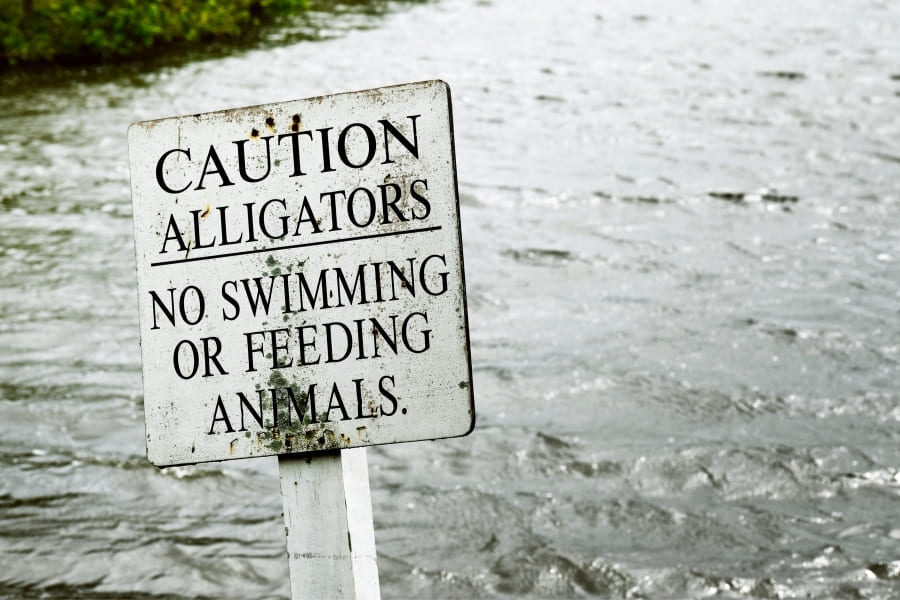
When dealing with alligators and crocodiles, you should follow these guidelines:
- Only swim in designated areas, and only in the daytime.
- Do not walk too close to river banks. Breeding females, in particular, do not take kindly to intruders.
- Put your dog on the leash when walking next to a river, so it does not stir up an alligator.
- Should an alligator chase you, run away. The animals are good sprinters, but lack the stamina for a long pursuit.
- If you are being attacked by an alligator: Fight back with everything you have and aim for its eyes and snout.
- Due to risk of infection, even baby alligator bites have to be treated immediately.
- If you see an alligator on the road, keep your distance. Call the police or the alligator hotline (866-392-4286). Feeding or harassing the animals is punishable by law.
Alligator Watching in Florida – the best Places
Fans of the primeval reptiles will love the Sunshine State. There is hardly a better place in the USA to go alligator watching than Florida.
Alligators in Zoos and Aquariums
If you want to see many alligators in one spot and learn more about these animals, you should visit the following places. There, you can observe Florida’s alligators in zoos and aquariums:
Gatorland
This theme park near Orlando has been in operation since 1950. The slogan “Gator Capital of the World” is appropriate: 2.000 alligators and crocodiles live here – among them two rare albino alligators. At the Baby Gator Marsh area you can see cute hatchlings. And Gatorland is not just home to American species. Nile crocodiles and Caribbean specimen live here as well. You are not happy just watching the animals from the ground? Then take the zip line for a high-speed ride over the crocodile enclosure.
GatorWorld Parks
GatorWorld Parks near Orlando is another prime spot for alligator fans. Here, you can drive your car past artificial lakes with more than 400 animals. A real celebrity is “Big Al”, a 13 feet giant that you can even take a selfie with. In addition, you can also hold a less-threatening baby gator. Their older brethren are kept in a special enclosure, where visitors feed them pieces of meat.
St. Augustine Alligator Farm Zoological Park
The St. Augustine Alligator Farm Zoological Park has dedicated a whole section to the primeval reptiles: “Land of Crocodiles”. Here, you cannot only see rare albino crocodiles. Their smaller Chinese cousins live here, too – just like Nile crocodiles and thin-snouted gharials. In addition, the area houses the taxidermied remains of Gomek, a 16 feet behemoth. Behind glass walls, you can watch Maximo, a saltwater crocodile measuring 13 feet. Thrill-seekers should try the obstacle course “Crocodile Crossing” above the crocodile enclosure – while wearing a safety harness, of course.
Alligator Attraction
At the Alligator Attraction in Madeira Beach, visitors get close to wild animals. Here, children can feed alligators with rods, hold the reptiles and even kiss a baby gator. Luckily, the young one has its snout taped shut, so it cannot kiss back.
Smugglers Cove Adventure Golf
Another popular destination for families is Smugglers Cove Adventure Golf in Fort Myers Beach – perfect if you cannot choose between minigolf and alligators. Located at the centre of the course is a lake with 20–30 adolescent animals. Here, you can feed the alligators with bamboo poles after completing the golf course.
Everglades Alligator Farm
Hunting wild alligators is illegal in Florida. Therefore, around 45.000 alligators are bred in captivity for their leather and meat. 2.000 of them live on the Everglades Alligator Farm in Homestead. Here, you can watch the hungry reptiles getting fed, and also witness an ancient sport: Alligator Wrestling. During the show, trainers perform daredevil stunts like sticking their head in the animal’s mouth. In the end, however, it is the alligator that gets eaten. Fried Gator Bites with hot sauce are a popular dish in the Southern Cuisine.
Other places where you can see alligators
More places with alligators include:
- Florida Aquarium (Tampa)
- ZooTampa at Lowry Park (Tampa)
- Everglades Holiday Park (Fort Lauderdale)
- Naples Zoo (Naples)
- Conservancy of Southwest Florida (Naples)
- Shell Factory and Nature Park (Fort Myers)
- ZooMiami (Miami)
- Gator Beach (Pensacola)
- Panama City Beach Zoo (Panama City Beach)
Alligators in the Wild
If you want to see Florida´s alligators in the wild, you should try your luck at the following places:
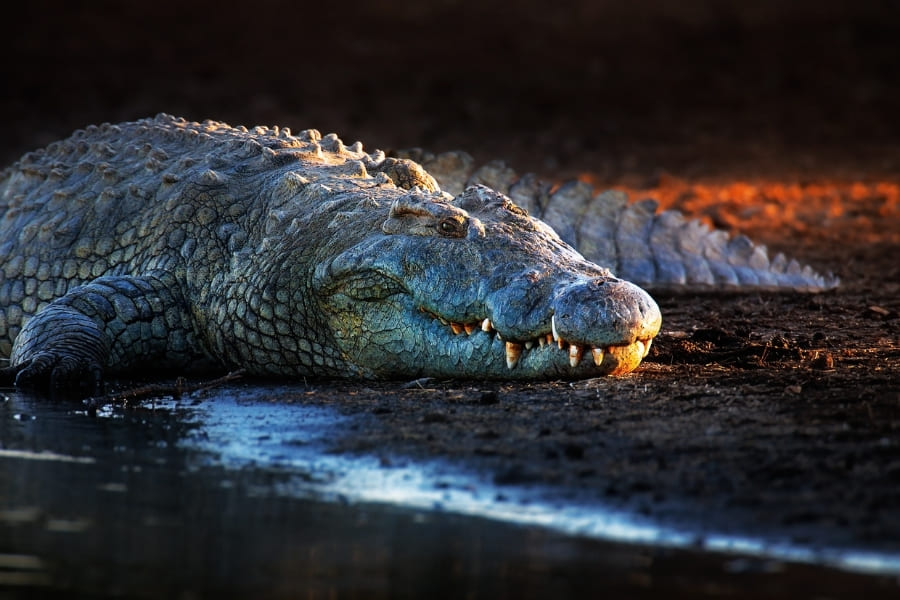
Everglades National Park
Florida’s River of Grass is by far the best place to see alligators in the wild. It is also the only place where the reptiles share their habitat with crocodiles. There are many possibilities to explore the National Park:
While hiking on the Tamiami Trail in Shark Valley, or the short, beginner-friendly Anhinga-Trail, you are almost guaranteed to spot alligators sunbathing in the water. Alternatively, watch the reptiles on the trails starting at the National Park entrance in Homestead. Of course, you can also launch your kayak at the Nine Mile Pond and observe alligators in the brackish water. Legend has it that a 15 feet monster called “Croczilla” still lives there. Gators are a main attraction on the popular airboat tours. Here, you can even have your photo taken with a (harmless) baby alligator.
Oasis Visitor Center im Big Cypress Preserve
Around 1.500 alligators live in this reserve north of Everglades National Park. Some of them can already be spotted from the parking lot. If you want to see more, take the 5 minute loop trail beginning at the Oasis Visitor Center. Here, you can comfortably watch the reptiles from wooden boardwalks. If you are lucky, you might even catch them hunting. Alternatively, drive your car through the preserve, or go alligator watching on a kayak ride.
Myakka River State Park
This gator refuge is located in Sarasota County. Particularly large groups can be seen around the “Deep Hole” pond that you reach on a 4 mile loop trail. Only 30 visitors are allowed in the State Park every day, so you should get there early. It also pays to visit on a day with no wind, as the alligators like to hide when it is breezy.
Wakulla Springs State Park
This park south of Tallahassee is not just popular with swimmers who want to cool off in its springs. On an airboat tour you can watch alligators sunbathing. The most remarkable specimen, however, is kept at the Wakulla Springs Lodge: “Old Joe”, a 10 feet long alligator that was killed in 1966.
Hillsborough River State Park
Visitors to the Tampa Bay area can see alligators at this nature reserve – no matter if they want to go hiking, cycling or kayaking. The gators are often spotted tanning on driftwood or relaxing on the shore.
Other places
You can also see Alligators in the following places:
- Corkscrew Swamp Sanctuary near Naples
- Sawgrass Lake Park in St. Petersburg
- Merritt Island State Wildlife Refuge near Kennedy Space Center
- Ocala National Forest north of Orlando
- Everglades & Francis S. Taylor Wildlife Preserve west of Fort Lauderdale
- J. N. “Ding” Darling National Wildlife Refuge on Sanibel Island
Crocodile Facts
Not every huge reptile in the Sunshine State is an alligator. We will present you the most important crocodile facts:
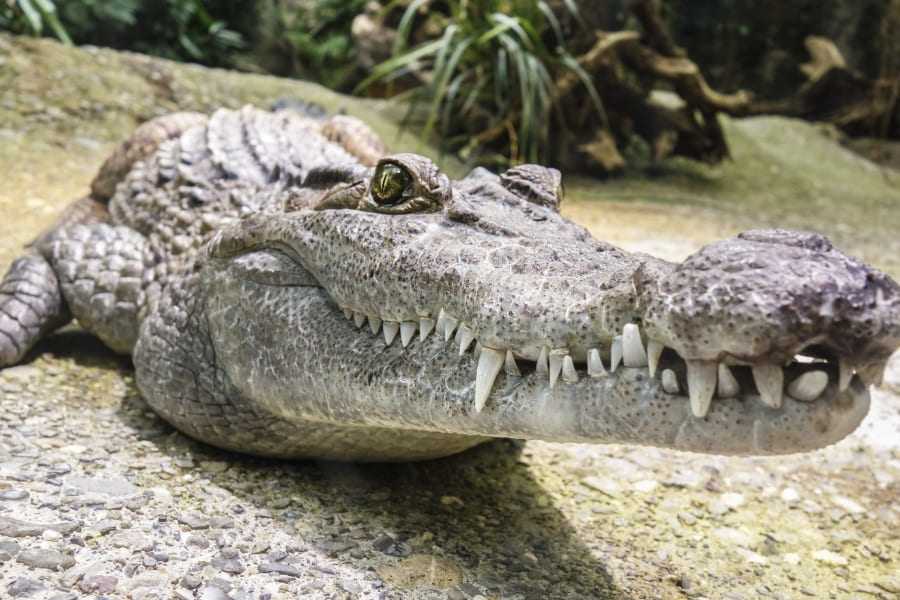
Crocodile Species
The family of the so called true crocodiles includes 15 to 19 species: among them Australian saltwater crocodiles and species in Africa, South Asia, North America and South America. Florida is home to the American crocodile.
Did you know? “There are also white crocodiles. It is estimated that one in 20.000 crocodiles is affected by albinism.”
Crocodile Habitat
Crocodiles are not picky when it comes to their habitat: They live in freshwater bodies like rivers, lakes and swamps, but also in brackish water. You can even see crocodiles in the ocean. In Florida, the reptiles concentrate in the warm south: particularly in the Everglades, the Florida Keys and south of Tampa and Miami.
Crocodile Size and Weight
As one of the largest crocodile species in the world, the American Crocodile can reach a length of 23 feet and a weight of 880 lbs. The females can be distinguished from the males by their smaller size.
Crocodile Diet and Behavior
Crocodiles have a varied diet. Their food includes snails and crabs, as well as fish, tortoises and birds. Even grown cattle sometimes fall victim to the reptiles.
Crocodiles are solitary animals that fiercely protect their territory. In the daytime, they display a largely inactive behavior. The animals usually hunt at night.
Crocodile Babies
Crocodile babies hatch after an incubation period of 75 to 80 days. They usually measure 9.4–10.6 inches in length and know how to hunt right after birth. Despite this, young crocodiles spend several weeks with their mother.
Alligators and Crocodiles – the Differences
Alligators and Crocodiles share some similarities. However, you can tell them apart if you look at the following differences:
- Compared to alligators, crocodiles have a longer, thinner snout – as can be clearly seen in crocodile pictures. Their mouths are shaped like a “V”, whereas alligators have a “U” shaped snout.
- If you can see the animal’s upper and lower teeth, you are looking at a crocodile. In contrast, alligators have dominant upper jaws that cover their lower jaws.
- While both reptiles have green skin, crocodiles sport a fairer skin tone than alligators.
- If you encounter a large reptile in the ocean, it is most likely a crocodile. Alligators, on the other hand, are not well adapted to saltwater.
In the wild, you hardly ever have to ask the question: crocodile or alligator? While the Sunshine State is populated by a whopping 1.3 million alligators, only 2.000 crocodiles are estimated to remain in the wild.
Seeing Crocodiles in Florida – the best Places
Whether in the wild or in zoos – the following places are perfect if you want to see crocodiles in Florida:
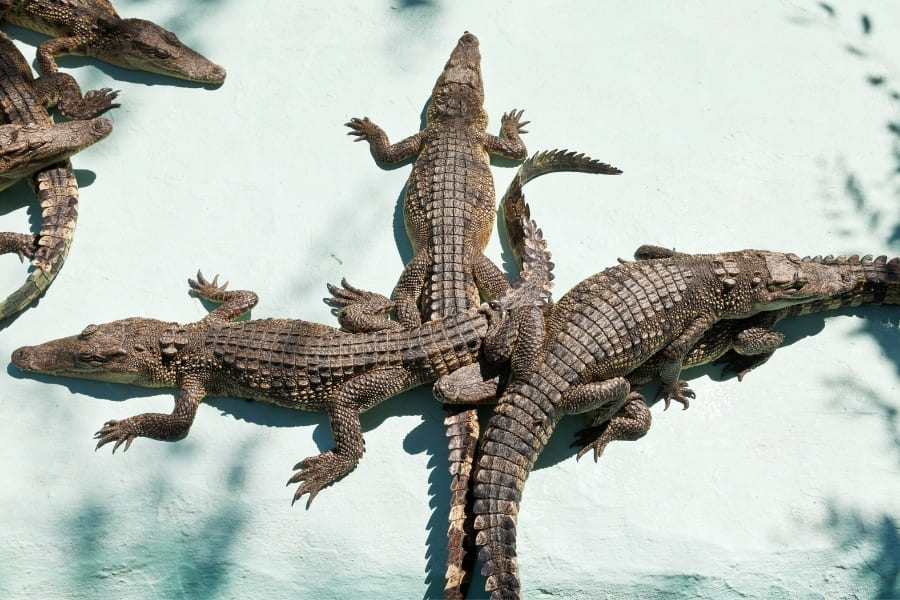
Crocodiles in Zoos and Aquariums
If you want to see Florida’s crocodiles in captivity, we can recommend the following zoos and aquariums:
- Gatorland (Orlando)
- Croc Encounters (Tampa)
- Everglades Holiday Park (Fort Lauderdale)
- Central Florida Zoo & Botanical Gardens (Sanford)
- Brevard Zoo (Melbourne)
- ZooMiami (Miami)
Crocodiles In the Wild
Crocodiles are not a common sight in Florida. However, if you want to see these animals in the wild, you should try your luck in the following places:
- Everglades National Park: Here, crocodiles share their habitat with the more common alligators.
- Marina of Flamingo in the southern Everglades
- southern Biscayne Bay
- northeastern Florida Bay
- Shark River to Sanibel Island and the coastal waters around Cape Coral
- Broward County
- Florida Keys, especially Key Largo
Alligators and Crocodiles in Florida FAQ – frequently asked Question
Where do alligators live in Florida?
Florida’s alligators can be found in all freshwater habitats, from the north of the state to the Florida Keys in the South. In saltwater, however, the reptiles are a rare sight.
How old do alligators get?
In the wild, most alligators reach an age of 30–50 years. In captivity, however, their lifespan can be much longer. The best example is 83 year old Muja, the oldest alligator in the world.
What do alligators eat?
Alligators predominantly feed on fish, small mammals, tortoises and birds. Young animals mostly eat larvae, snails and mollusks.
Do alligators eat people?
Under normal circumstances, alligators do not attack people, and humans are not part of their diet. However, alligators have attacked in the past when they were provoked or mistook humans in the water for prey.
How many alligators live in Florida?
With a population of 1.25 million animals, Alligators are a common species in Florida. They are not endangered or threatened anymore.
Where do crocodiles live?
American crocodiles populate the tropical south of Florida, the Everglades and coastal areas as far north as Miami and Tampa. In addition, the species is found in the Caribbean, Latin America and northern parts of South America.
What is a crocodile’s favorite food?
Crocodiles are omnivores that feed on fish, mammals, birds, snakes and tortoises. They have even been observed to attack sharks. Crocodiles are also cannibals that eat smaller crocodiles.
How big are crocodiles?
American crocodiles can reach a length of up to 23 feet. However, 9.8–13 feet are the norm for male specimen.
How old do crocodiles get?
In the wild, crocodiles usually live for 30–70 years – if they do not fall to predators at a young age, that is.
How long have crocodiles lived on earth?
Crocodiles are living fossils that have populated our planet for the last 200 Million years. This means that the first Crocodiles coexisted with dinosaurs.
Do crocodiles eat people?
Due to their small population, encounters between humans and crocodiles are exceedingly rare – as are deaths by crocodile. Although American crocodiles are more aggressive than alligators, the species is not known for deliberately attacking or eating humans.
How many crocodiles live in Florida?
Only about 2.000 crocodiles remain in the wild in Florida. However, strict protection measures have prompted an increase in crocodile numbers.


